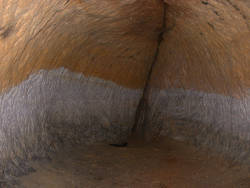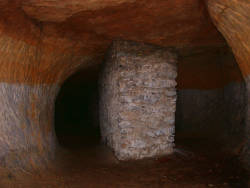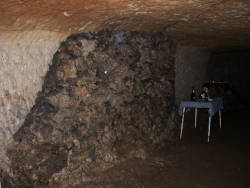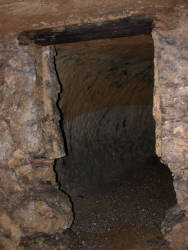Egloffsteiner Felsenkeller
Egloffstein Cellars
Useful Information


| Location: |
Felsenkellerstraße 22, 91349 Egloffstein.
In the town Egloffstein, in the Felsenkellerstraße. Two entrances below the Raiffeisenbank car park. (49.701890, 11.259350) |
| Open: |
APR to SEP no restrictions. [2024] |
| Fee: |
Free. [2024] |
| Classification: |
 Cellars Cellars
|
| Light: | bring torch |
| Dimension: | L=700 m, Ar=12.000 m², T= 8 °C. |
| Guided tours: | self guided after appointment with the tourist office |
| Photography: | allowed |
| Accessibility: | yes |
| Bibliography: | |
| Address: |
Felsenkeller Egloffstein, 91349 Egloffstein, Tel: +49-9197-202-1544.
E-mail: Tourist-Information Egloffstein, Felsenkellerstr. 20, 91349 Egloffstein, Tel: +49-9197-202. E-mail: Michael Wirth, Egloffstein, Tel: +49-9197-1544. E-mail: |
| As far as we know this information was accurate when it was published (see years in brackets), but may have changed since then. Please check rates and details directly with the companies in question if you need more recent info. |
|
History
| 1728 | used as quarry for rocks and sand by the Rittergut Egloffstein. |
| 19th century | 24 cellars constructed by adding walls and doors. |
Description




In the town Egloffstein in the Fränkische Schweiz (Frankian Switzerland) a system of cellars is open to the public. It is located in the middle of the town below the road Felsenkellerstraße, which was named after the cellars. The name Egloffsteiner Felsenkeller (Rock Cut Cellars of Egloffstein) is not really a name, it is simply descriptive. The cellars are located in 15 m thick layer of soft sandstone and cover an area of 12.000 square meters. 14 paralel tunnels have a total length of 700 m. The cellars are open to the public and can be visited self-guided without any restriction, but there are also guided tours which are very informative. However, they are used by bats for hibernation and therefore may not be entered in winter due to bat protection. They are offered by Michael Wirth, a local who knows the cellars since he was playing hide and seek here as a child.
The plateau of the Fränkische Schweiz (Frankian Jura) is composed of hard limestones and dolomites of the Upper Jurassic (Malm). But the deep valley of the Trubach river cuts through those layers into the softer yellow and brown-reddish sandstones of the Middle Jurassic (Dogger) Those soft stones were easy to mine, manually with rather primitive tools, so they were used in the Middle Ages to build houses, erect the castle above, and to produce sand for mortar. But the people soon learned that the underground spaces had other practical uses. They stored beer and vegetables, meat and anything else which needed cooling. The temperature inside the cellars is 8 °C, which is only three degrees higher than modern refrigerators. And the humidity was ideal to store potatoes and other roots. And finally the cellars were dug horizontally into the rock, so it was possible to drive into the cellar from the road with a cart. No need to haul goods up and down a staircase. And finally the people of the village used the cellars as hideouts, it was much closer than the castle on the top of the plateau, so it was faster to get there.
Today the cellars are mostly empty. Only a part of one tunnel is still used by the locals to store goods. When the Felsenkellerstraße was modernized, the openings into the cellars were left open at the foot of the road basement. They are still open and accessible 24/7. It’s a sign how tranquil this town is, that they have not been vandalized!

|
| Egloffsteiner Felsenkeller Gallery |
- See also
 Search DuckDuckGo for "Egloffsteiner Felsenkeller"
Search DuckDuckGo for "Egloffsteiner Felsenkeller" Google Earth Placemark
Google Earth Placemark OpenStreetMap
OpenStreetMap Egloffsteiner Felsenkeller
Egloffsteiner Felsenkeller  (visited: 18-JAN-2019)
(visited: 18-JAN-2019) Felsenkeller Egloffstein, official website
Felsenkeller Egloffstein, official website  (visited: 18-JAN-2019)
(visited: 18-JAN-2019) Felsenkeller Egloffstein
Felsenkeller Egloffstein  (visited: 18-JAN-2019)
(visited: 18-JAN-2019) Felsenkeller: In Egloffsteins Unterwelt
Felsenkeller: In Egloffsteins Unterwelt  (visited: 18-JAN-2019)
(visited: 18-JAN-2019)
 Index
Index Topics
Topics Hierarchical
Hierarchical Countries
Countries Maps
Maps